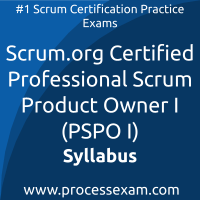 To achieve the professional designation of Scrum.org Professional Scrum Product Owner I from the Scrum.org, candidates must clear the PSPO I Exam with the minimum cut-off score. For those who wish to pass the Scrum.org Professional Scrum Product Owner certification exam with good percentage, please take a look at the following reference document detailing what should be included in Scrum.org PSPO 1 Exam preparation.
To achieve the professional designation of Scrum.org Professional Scrum Product Owner I from the Scrum.org, candidates must clear the PSPO I Exam with the minimum cut-off score. For those who wish to pass the Scrum.org Professional Scrum Product Owner certification exam with good percentage, please take a look at the following reference document detailing what should be included in Scrum.org PSPO 1 Exam preparation.
The Scrum.org PSPO I Exam Summary, Sample Question Bank and Practice Exam provide the basis for the real Scrum.org Certified Professional Scrum Product Owner I (PSPO I) exam. We have designed these resources to help you get ready to take Scrum.org Professional Scrum Product Owner I (PSPO I) exam. If you have made the decision to become a certified professional, we suggest you take authorized training and prepare with our online premium Scrum.org Professional Scrum Product Owner Practice Exam to achieve the best result.
Scrum.org PSPO I Exam Summary:
Scrum.org Professional Scrum Product Owner Syllabus Topics:
|
Topic |
Details |
|
Understanding and Applying the Scrum Framework |
Empiricism
-
In Scrum, empiricism refers to the idea that solving complex problems, or doing complex work, can only be done using an exploratory process rather than relying on predetermined plans. Learn about empiricism and complex work. Explore why trust is important for empiricism to thrive.
The Scrum Team
-
The Scrum Team is a small unit of professionals focused on attaining the Product Goal. Scrum Teams consist of a Product Owner, Scrum Master and Developers. Each has a clear set of accountabilities. Learn more about the Scrum Team, accountabilities, responsibilities and why these aren’t called “roles.”
The Scrum Events
-
The five Scrum Events provide regular opportunities for enacting the Scrum pillars of Inspection, Adaptation and Transparency. In addition, they help teams keep aligned with the Sprint and Product Goals, improve Developer productivity, remove impediments and reduce the need to schedule too many additional meetings.
The Scrum Artifacts
-
Learn about the three Scrum artifacts and their commitments: Product Backlog and Product Goal; Sprint Backlog and Sprint Goal; Increment and Definition of Done. Explore some common antipatterns and myths that surround these artifacts.
Definition of Done
-
The Definition of Done describes the quality standards for the Increment. Learn why getting to Done is so important, what undone work is, if it’s okay to show work that isn’t done to stakeholders, can you present undone work at the Sprint Review and what’s the difference between the DoD and Definition of Ready or acceptance criteria.
|
|
Developing People and Teams |
Self-Managing Teams
-
The best way to support a team working on complex problems is to give them the space to determine how to do their work, rather than directing them. Learn about self-managing teams and their characteristics. Explore some myths and misunderstandings about self-management.
|
|
Managing Products with Agility |
Forecasting and Release Planning
-
Scrum Team can use forecasting and release planning as a guide for delivering a product through small incremental and frequent releases rather than big bang product launches.
Product Vision
-
The Product Vision describes the purpose of a Product. A good Product Vision expresses the value the Product should deliver and to whom that value is delivered.
Product Value
-
The objective of a Scrum Team is to deliver value to customers and stakeholders. Product Value actively drives customer satisfaction, loyalty, brand reputation, and the longevity of a business by providing customers with benefits that satisfy their needs.
Product Backlog Management
-
Product Backlog Management is the act of adjusting and ordering items on the Product Backlog so that the Scrum Team can deliver the most valuable product possible. This learning series explores Product Backlog Management.
Business Strategy
-
Business strategy is informed by the company’s mission and vision, and in turn informs individual product visions. An organization inspects and adapts its business strategy based on feedback gathered from delivering product Increments.
Stakeholders and Customers
-
Scrum encourages frequent collaboration with stakeholders, and customers in particular. Understanding how to identify and learn about the challenges that key stakeholders face will help the Scrum Team better deliver the value they are seeking.
|
Both Scrum.org and veterans who’ve earned multiple certifications maintain that the best preparation for a Scrum.org PSPO I professional certification exam is practical experience, hands-on training and practice exam. This is the most effective way to gain in-depth understanding of Scrum.org PSPO 1 concepts. When you understand techniques, it helps you retain Scrum.org Professional Scrum Product Owner knowledge and recall that when needed.
 To achieve the professional designation of Scrum.org Professional Scrum Product Owner I from the Scrum.org, candidates must clear the PSPO I Exam with the minimum cut-off score. For those who wish to pass the Scrum.org Professional Scrum Product Owner certification exam with good percentage, please take a look at the following reference document detailing what should be included in Scrum.org PSPO 1 Exam preparation.
To achieve the professional designation of Scrum.org Professional Scrum Product Owner I from the Scrum.org, candidates must clear the PSPO I Exam with the minimum cut-off score. For those who wish to pass the Scrum.org Professional Scrum Product Owner certification exam with good percentage, please take a look at the following reference document detailing what should be included in Scrum.org PSPO 1 Exam preparation.